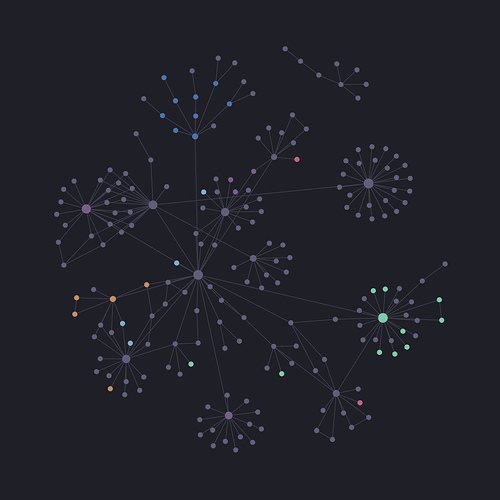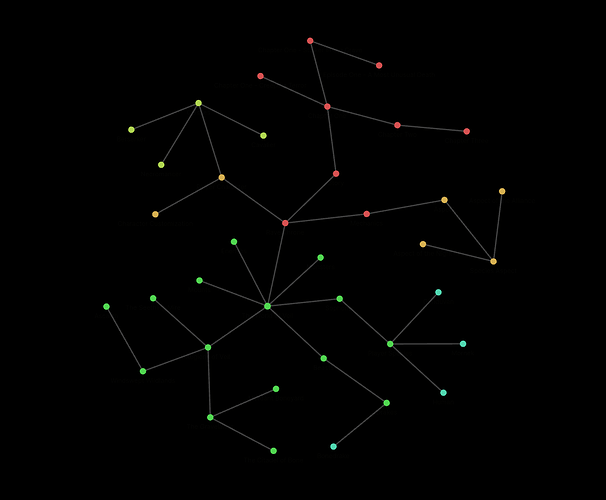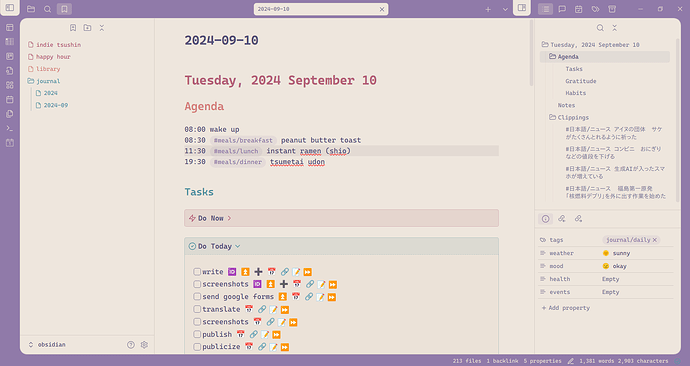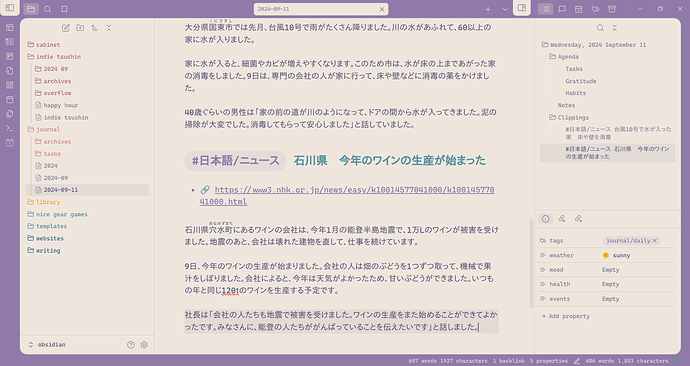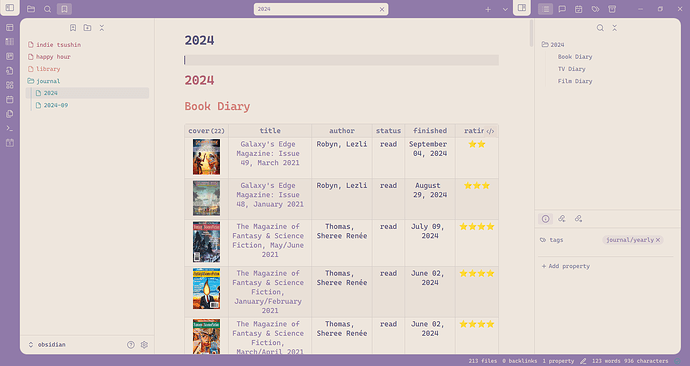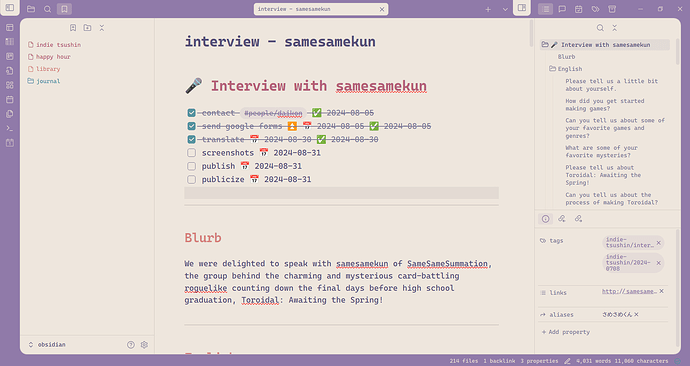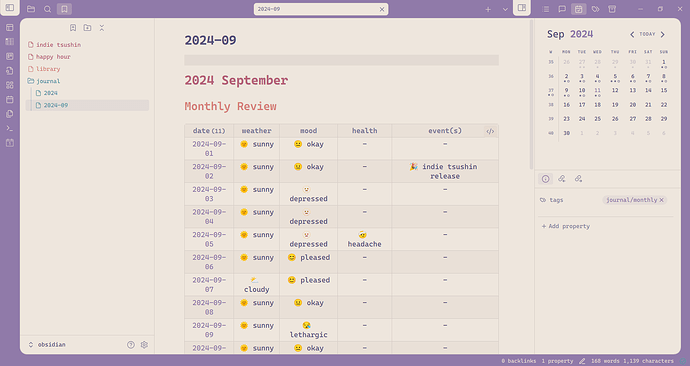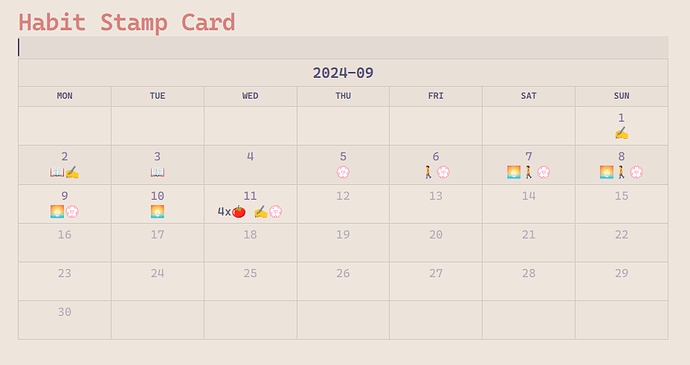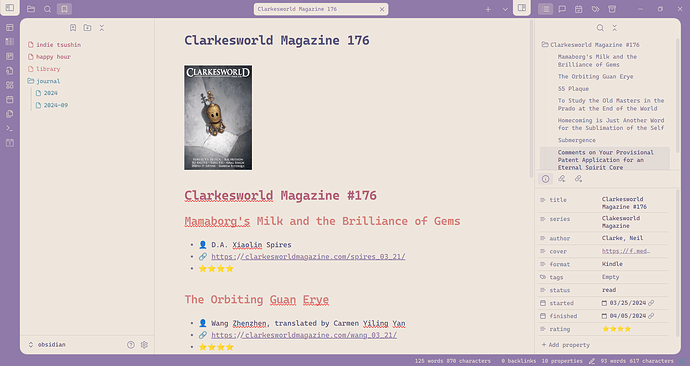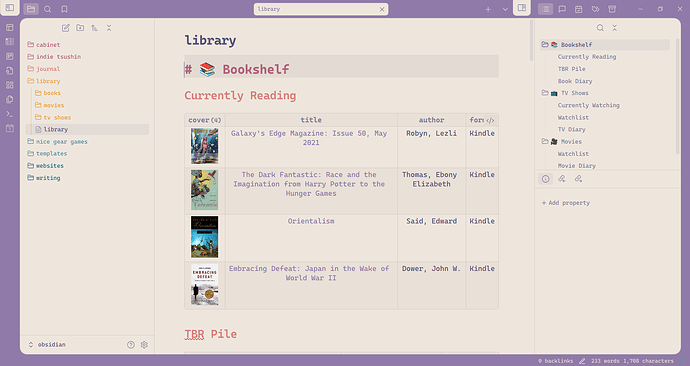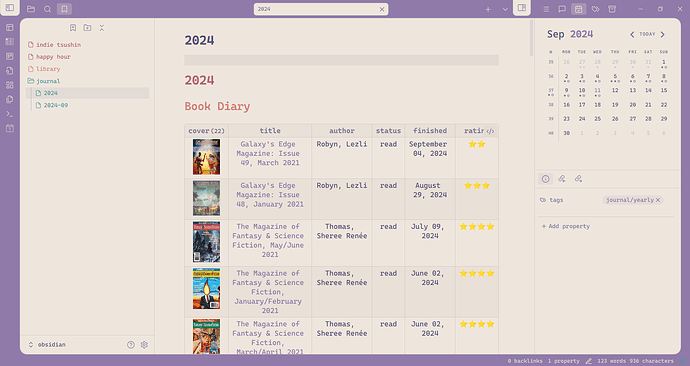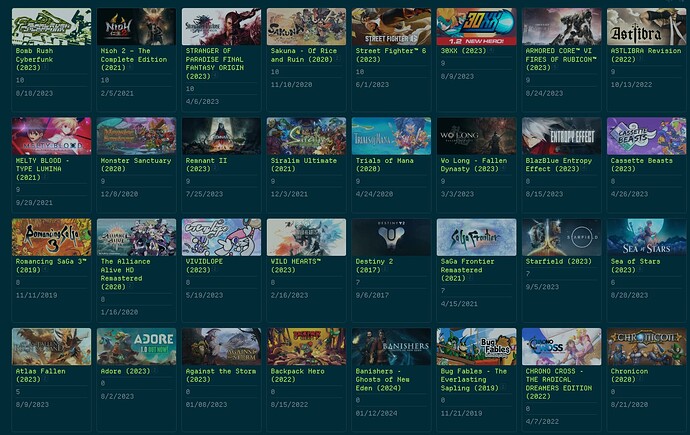this is genuinely lovely to look at. I aspire to this.
I guess I mostly just gotta get into the habit of actually making the links between posts, I think the stuff you’ve got on Taniyn with Publish basically making a wiki-slash-blog site is pretty neat.
been trying to figure out options for a personal site considering recent events lol
Yeah I mostly treat it as “separate pages you can softly wiki up over time”
What I really recommend doing is hiding the file tree. Make a main page with links instead[1]. This is pretty much the way to go no matter what you end up using it for.
And then find a way that works for you of quickly navigating there. ↩︎
Awesome, thanks!
Seems like Vercal or the plugin isn’t generating it though which is a bummer.
Yep. I’m not using it for a site, just local organization, so I do this via a canvas. Hasn’t steered me wrong yet. (Though I like having a filetree that’s well maintained too because it lets me do useful dataview things like automatically displaying which notes exist in X folder in order.)
Ye! When I was playing Celeste Strawberry Jam, I wanted to write mini reviews for each stage, and I put them all in a folder so that I could make a table out of them. Like, /db/strawberry jam levels/*. But those are like one-time setup things, most of the time most things are a flat folder for me.
still small, but growing all the same. I get some dandelion structures since I have my physical game collection split up by system and I have separate notes for all my game reviews.
it’s not really represented here but I also do a lot of tagging since the directory tree is mooostly flat.
The hexlists you see on the left here are generated from dataviews from those split folders. Admittedly this is a pretty unusual use case from what most people do with obsidian!
Oh, right, I should mention: The entirety of that Blades in the Dark lineage thing was done in an Obsidian canvas.
This is what I’ve got so far for one of my MMO projects (no plans on making it a real thing but figuring out mechanics and item drop rates is really fun). Still really small but it’s still progressing, even if it is a bit slow.
The red nodes are for things that relate to the “game” itself, orange nodes relate to the player, the yellowish nodes relate to the classes, the green nodes relate to the world it takes place in, and the teal nodes relate to the species found in this world (including player species). There’s a bit of overlap between groups, but it makes sense to me so that’s what I’m going with. I’ll probably adjust the colors at some point but that’ll wait until I figure out other groups (there will definitely be an item group at some point, and probably a boss one as well)
OK! Got it!
For anyone else making a Digital Garden, your RSS feed is hidden in src/site/feed.njk
I also am an Obsidian fiend, ahaha. I use it as a daily journal, media tracker, and text editor for Indie Tsushin and other projects. I use the Daily Note to journal about the weather, mood, events, etc. in the note metadata (which I pin to the bottom right), track meals, habits, and gratitude journal, write notes bullet journal style, and clip stuff from around the web to study later (usually short Japanese articles etc) which I then tag by topic. I also use the Tasks plugin to pull all the tasks due today:
I also have a library folder where I dump books/movies/TV shows/ etc, plus the notes I have for them. Then I use Dataview + Periodic Notes plugins to make monthly and yearly “media in review” kinda pages. I like tracking stuff this way rather than Letterboxd et al because I don’t want people seeing my star ratings and making fun of my trash tastes LOL ![]() Also it’s a lot handier to take notes and link them to my daily notes, etc.
Also it’s a lot handier to take notes and link them to my daily notes, etc.
I also use this Habit Calendar plugin to grab my daily habits and make a cute little stamp card for my monthly page, hehe
What I am SUPPOSED to be doing however is using Obsidian to Get Shit Done, namely Indie Tsushin stuff. I use the Kanban plugin to organize the notes I need to work on, and make heavy use of the Outline + Enhanced Annotations plugins to jump around my document.
Anyway here are more ideas for how to use Obsidian! I too don’t know how to use it quote-unquote correctly ahaha, I have no idea what the graph mode is for and don’t bother with canvases/etc. But it’s fine!
The graph is useless tbh outside of aesthetics or to find pages that have no connections to anything else. I don’t use canvases either
Neat that you use tasks, I haven’t been able to find a way to fit them in
@renkotsuban looking forward to digging into this when I’m home later, because I see a lot of things we do similarly and I think I might pick up some tips. using the metadata to journal stuff is really clever, I love it!
Shit I really gotta dig into the productivity aspects, having it be a kanban like trello but not garbage sounds fantastic. I’ve just been using it for like, pre-layout game writing.
okay wait this might save me tons of time. I maintain a manual list at the moment. if you feel OK sharing, what does the content of one of the library entries (so a game, book, movie, etc.) look like?
Yeah! I used to use this app Daylio on my phone, basically just tapping through lists to make quick journal entries. This metadata version sorta recreates that, just click on the property and choose from the dropdown (or start typing to autocomplete), plus a lot more flexible since you can make new moods/activities/etc super easily.
It’s pretty barebones, but on my Month template I put something like this:
```dataview
table without id
file.link as "date",
weather,
mood,
health,
events as "event(s)"
from "journal/{{date:YYYY/MM}}" and #journal/daily
sort file.name asc
And then when I make the month page, it spits out a table like this:
(lmao September has not been a good month so far ![]() )
)
For the Habit Stamp Card, I use this plugin. Then in my Daily template, I put something like
- [ ] #habits 🍅 do (pomodoro::4) pomodoros
- [ ] #habits 🌅 wake up on time (earlyBird::true)
- [ ] #habits 🏋️ exercise (exercise::true)
- [ ] #habits 🚶 take a walk (walk::true)
- [ ] #habits 📖 read (read::true)
- [ ] #habits ✍️ write (write::true)
- [ ] #habits 💮 study japanese (japanese::true)
(notice the way that the pomodoros are written, you can edit that 4 to be however many pomos you did that day and then check it off)
Then on the Month template I put:
```dataviewjs
let pages = dv.pages(`"journal"`)
const year = {{date:YYYY}}
const month = {{date:M}}
const date_pattern = 'YYYY-MM-DD'
const habit_tag = '#habits'
const habits = {
'pomodoro': '{habit}x🍅 ',
'earlyBird': '🌞',
'exercise': '🏋️',
'walk': '🚶',
'read': '📖',
'write': '✍️',
'japanese': '💮',
}
let data = {}
for (let page of pages) {
let date = page.file.name
data[date] = data[date] || ''
for (let task of page.file.tasks.filter(task => task.tags.contains(habit_tag) && task.checked)) {
for (let habit in habits) {
if (task[habit]) {
data[date] += habits[habit].replace('{habit}', task[habit])
}
}
}
}
let calendarData = []
for (let date in data) {
calendarData.push({date: date, content: data[date]})
}
renderHabitCalendar(this.container, dv, {year, month, data: calendarData, date_pattern})
(again notice how the “pomodoros” variable is written, you can use this to put numbers on your habit calendar like “#km run” or “# minutes read” or something)
Then I check off the hobbies I do on my Daily pages, which looks like this on my Month page:
I really like the “stamp card” approach to habits, I am horrible at thinking in terms of streaks. Once I break a streak, there goes all my motivation to ever do that thing again… but collecting stamps is fun, and if I break my “streak” of stamps it’s whatever, I can collect other stamps, and then get back on that specific habit later when I feel like it.
If you prefer streaks instead, I know there’s a heatmap plugin that is very similar, and that one I think uses the metadata (i.e. not checkboxes, like the one I use).
I actually stole this idea from the Book Search plugin ahaha, tho I no longer use that plugin because it has trouble finding periodicals, and these days I end up reading more litmags than actual books. Plus I ended up using this same template for movies, TV shows, and games too, so I just got used to not using the plugin.
This is what my books template looks like:
---
title: "{{title}}"
series:
author:
cover:
format:
tags:
status: not started
started:
finished:
rating:
---

# {{title}}
You can of course add or remove anything you don’t need.
So for example, this is what I used for Clarkesworld Magazine #176:
---
title: "Clarkesworld Magazine #176"
series: Clakesworld Magazine
author: Clarke, Neil
cover: https://f.media-amazon.com/images/I/81vX-xsjucS._SL1500_.jpg
format: Kindle
tags: []
status: read
started: 2024-03-25
finished: 2024-04-05
rating: ⭐⭐⭐⭐
---

# Clarkesworld Magazine #176
And then this is what it looks like:
(This is for a litmag with a lot of short stories so that’s why there are all the headings, if it’s a book usually I just dump quotes/notes in there)
Probably the most PITA part is copy+pasting in URLs for the book covers twice, once for the book’s metadata (so it shows up in Dataview tables) and once for the page itself. I have thought about using the Banners plugin to make the cover even more prominent rather than so obviously pasted in, but thought blah I don’t want to make too much work for myself lmao.
I have a Library page that shows my current books, my TBR, and my diary (list of read books). That all looks like:
# 📚 Bookshelf
## Currently Reading
```dataview
table without id
"" as cover,
link(file.link, title) as title,
author,
format
from "library/books"
where status = "currently reading"
sort file.mtime desc
## TBR Pile
```dataview
table without id
link(file.link, title) as title,
author,
format
from "library/books"
where status = "not started"
sort file.ctime asc
## Book Diary
```dataview
table without id
link(file.link, title) as title,
author,
status,
finished,
rating
from "library/books"
where status != "currently reading" and status != "not started" and finished != ""
sort finished desc
The reason I do status != "currently reading and status != "not started" instead of the more straight forward status: read is so that it also includes stuff like books I abandoned, paused, re-read, etc. If you don’t care about that stuff, you can just make that last one status = "read"
All of this looks like:
For my Year page, I have:
```dataview
table without id
"" as cover,
link(file.link, title) as title,
author,
status,
finished,
rating
from "library/books"
where status != "currently reading" and status != "not started" and finished >= date({{date:YYYY}}-01-01) and finished < date({{date:YYYY}}-12-31)
sort finished desc
Which makes something like:
That’s basically the gist of it! That Book Search plugin page has some more layout ideas and if you do use it, it should automate a fair chunk of this for you. Though as I said I don’t use it anymore and just use templates + Data View. Lemme know if you need any help!!
Sorry for these long walls o’ text lmao, I get very excited talking about Obsidian…
The Kanban plugin is so good ahaha, I like it for at-a-glance projects. Originally I had been putting status metadata on all my pages and then making a Project page with a Dataview table, but the Kanban plugin made it SUPER simple. I can just drag and drop pages onto the board, add dates to the cards (which link to that day’s Daily page!), set columns to auto-complete any cards that get dragged there, auto-archive entire columns, etc. It’s really handy, highly recommend!
this is all so great thank you so much!! looking forward to getting some quality time with my notebook this weekend hahah
